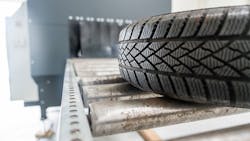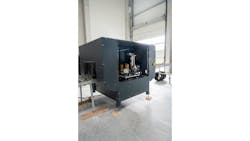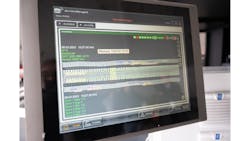German Company Develops AI-Enabled Tire Inspection System
TireTech has developed an AI-enabled tire inspection system for the tire recycling and disposal industry. The system, which uses 3D technology, scans individual tires and gathers data regarding the tire’s overall condition as well as its material makeup. Based on the information gathered, the tire can either be recycled for further automotive use or repurposed into granulate material.
TireTech (Friedberg, Germany) was formed in 2019 by mechanical engineers/entrepreneurs Karl Staudinger and Bernhard Brain. According to TireTech's website, Staudinger and Brain had, at the request of an automative manufacturer, designed inspection and sorting solutions for metal parts. However, while stopped at a gas station during a road trip, they started thinking about how tires are inspected and disposed of and whether they could develop a similar solution for tires. Their subsequent research found that tire disposal was not only done manually, but was also time-consuming, taking, on average, around two minutes per tire for disposal.
Staudinger and Brain decided to launch a new company for the purpose of developing an automated inspection system for testing and handling of tires that is not only user-friendly but also collects all important information from the tire, then documents and evaluates that information to determine which used tires can be brought back on the market for a second life.
Reusing tires helps address an environmental problem. In Europe, for example, 3.2 million tons of old tires accumulate every year, according to TireTech’s research.
TireTech, which markets its system to tire recycling and disposal companies, notes that the automated process not only helps achieve environmental goals but also is much more efficient than manual inspecting and sorting processes. On average, only one employee is needed to operate the system, compared with between two and six employees for a manual process.
And it is fast, inspecting up to 360 tires per hour.
Seeking Solutions
TireTech’s co-founders first set out to build a machine that could test and evaluate tires for tread longevity, size, and brand. Then, having decided the system needed to gather more information, they added more criteria for inspecting individual tires, such as whether it was a winter or summer tire, what the load possibilities were (road index), how fast one could drive with the tire (speed index), whether the tire had a reinforced sidewall (flat tire) or whether the tire was made with an adhesive compound (ContiSeal or ContiSilent). They finished their system in 2020, although work continues to further improve and tweak it, says Marcel Staudinger, TireTech project manager.
Anatomy of the System
The inspection system TireTech developed starts with a robust steel enclosure, Staudinger says. For the inspection, a tire is transported to the center of the machine via conveyor system. The tire is then positioned horizontally on a ball plate, which will lift slightly for the scan. 3D triangulation cameras are moved into position and the tire is rotated and scanned. The scan must be done while the tire is rotated in order to obtain an all-round scan of the tire.
The system can be operated and monitored by one employee at a tire disposal company, who can see the inspection results on a monitor attached to the machine or at a remote computer, explains Armin Jehle, Automation Technology's senior sales manager. Depending on the customer’s needs, the tires can be put manually on the conveyor belt, or they can be placed automatically, such as when the inspection machine is in a production line, Jehle adds.
The scan is performed using three 3D cameras—each of which is equipped with a C6 2040 laser triangulation sensor and laser, Jehle said. Triangulation, which is based on trigonometry principles, is a measurement method that determines distance by calculating continuous angles. In the tire inspection process, laser triangulation determines the tire’s contour, which in turn enables the scan to measure height, shape and volume, as well as detect contour errors and other such defects or anomalies.
The cameras are made by Automation Technology (Bad Oldesloe, Germany). For the scan, one camera is positioned above the tire sidewall and one below the tire sidewall. A third camera is used to measure tread depth.
“The only source of light comes from the cameras, which project a laser line onto the tires, which are then measured by the camera. This creates a 3D image of the tire, and we can then use our software to read and display the features on the tire,” Staudinger says.
He adds that they chose the AT C6 2040 sensors because of their speed—at up to 2048 pixels the profile speed is rated at .34 kHz—and their high resolution, 2048 x 1088, with a 5.5°µ x 5.5µ and 90dB dynamic range.
The AI-enabled Machine Vision Software
Staudinger said TireTech designed the machine and developed a prototype. TireTech partnered with machine vision experts at AKU Automation (Aalen, Germany), who designed and tested the camera and AI technology for the system.
For this project, the team used computers made by Bressner (Gröbenzell, Germany), Christian Merten, key accounts manager for AKU Automation, says.
“The computers we use are very fast — and very expensive,“ Merten says. “The computer is selected depending on how many neural networks and associated features we need to search.“
The team also built an extensive image database to train the AI models to evaluate tire features, Merten said. For this they used MVTec’s Halcon Deep Learning Tool and AKU’s visionManager software.
“The visionManager is our front end,” Merten says. “The Halcon software is the vision library that provides us, as a system integrator, with the different tools to create and program the application.”
A separate neural network is built for each inspection feature, such as DOT information, manufacturer, and tire size, Merten says.
“Since the tire manufacturers use different symbol sizes and shapes, these images have to be learned,“ Merten says. “The AI algorithm stores these images and uses the AI software to assign them to the different classes that the system generates itself.“
The camera takes the picture of the tire and sends it to the computer, then the algorithm accesses the database and can quickly assign the inspection result, Merten says.
“We install high-performance computers with graphics cards in the TireTech machines, which then access the (neural) network in the computer. We do not have an external cloud here but work absolutely self-sufficiently,“ Merten says.
Challenges
The team overcame challenges with reading alphanumeric information. There are many tire manufacturers, and they do not all place the alphanumeric information about the tire in the same place on the tire.
In order to solve this problem, the team placed cameras above and below the tire wall because the required information is usually placed on only one side of the tire—and as mentioned, not necessarily in the same place by every manufacturer.
Next Steps
Development of any such high-end machine vision system can be a complicated and lengthy work in progress. But overall, the tire inspection system has achieved TireTech’s goal of providing a solution to faster, more accurate, and environmentally friendly inspection and disposition of old tires.
“In the different readings, we came up with an average system performance of over 90%,” Merten says.
Currently, the system is on the market and can be configured for a variety of spaces, from small recycling operations to large manufacturing lines. In fact, three systems have been delivered since 2022, two in recycling facilities in the Netherlands and one in Germany; another five are scheduled for delivery and installation later this year.
Staudinger says the main applications most customers are using are the automatic sorting or the inspection/data collection aspects. However, there are other options available for the system. For example, some inspection systems can be fitted with a 2D camera that can scan the inside of a tire rim for information such as rim size and article number, as well as detect damage to the rim. However, this application is only required in wheel set storage and fleet management situations, Staudinger says.
TireTech is also developing a compact station for manual testing with AI support, which they hope to have on the market by the end of 2023, Staudinger says. This option will be geared toward very small operations such as automotive repair shops or tire dealers.
“We can proudly say that today we can offer a functioning, complete system, and, through constant further development, we can continue to improve and expand the process through progressive technologies in the future,” Staudinger says.
About the Author
Jim Tatum
Senior Editor
VSD Senior Editor Jim Tatum has more than 25 years experience in print and digital journalism, covering business/industry/economic development issues, regional and local government/regulatory issues, and more. In 2019, he transitioned from newspapers to business media full time, joining VSD in 2023.



